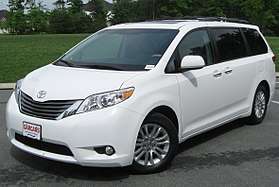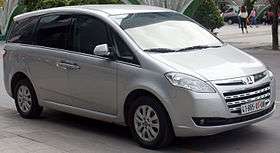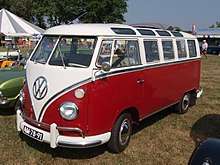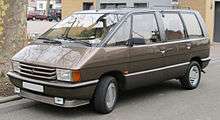Minivan



A minivan (American English), people carrier (British English),[1], MPV (multi-purpose vehicle) or MUV (multi-utility vehicle) is a vehicle size classification describing a high-roof vehicle with a flexible interior layout. Smaller sizes are mini MPV and compact MPV classifications.[2]
The minivan combines a high-roof, five-door one- or two-box hatchback body configuration with a mid-size platform, engine and mechanicals; car-like handling and fuel economy; unibody construction; front-wheel or all-wheel drive and greater height than sedan or station wagon counterparts. The design offers higher h-point seating, two or three rows of seating, easy passenger and cargo access with sliding wide-opening rear doors and large rear hatch, and a re-configurable interior volume with seats that recline, slide, tumble, fold flat or allow easy removal—enabling users to reprioritize passenger and cargo volumes.
Etymology
In North America, the term minivan derives from comparison to traditional full-size vans, including the Ford E-Series, Dodge Ram Van, and the Chevrolet Van. Full-size vans derived their underpinnings upon full-size pickup trucks, while the first generation of minivans sold in North America derived from either compact pickup trucks or passenger cars (or both).[3]
Antecedents





Predecessors include the 1936 Stout Scarab, which featured a removable table and second row seats that turn 180 degrees to face the rear.[4][5] The DKW Schnellaster, manufactured from 1949 to 1962 was one of the first vehicles to feature the characteristics of modern minivans.[6] In 1950, the Volkswagen Type 2 adapted a bus-shaped body to the compact Volkswagen Beetle. When Volkswagen introduced a sliding side door on their van in 1968, it then had the prominent features that would later come to define a minivan: compact length, three rows of forward-facing seats, station wagon-style top-hinged tailgate/liftgate, sliding side door, passenger car base. Fiat built a similar vehicle, the 1956 Multipla based on the Fiat 600 with the same rear engine, cab forward layout.
In 1972, designers at Ford Motor Company developed the Ford Carousel prototype as a variant of the upcoming redesign of the 1975 Ford E-Series. To better fit a van into a typical 7-foot (213 cm) tall American garage door opening, the Carousel was designed with a lower (6-feet tall) roofline and trim similar to a station wagon and a personal luxury car; rather than a cargo carrier, Carousel was intended a family vehicle. The vehicle was never produced, due to the mid-1970s fuel crisis and company financial difficulties. Nearly a decade later, the concept was revisited by designers and produced in somewhat different form as the Ford Aerostar.
In the late 1970s Chrysler began a six-year development program to design "a small affordable van that looked and handled more like a car".[7] The automaker introduced the first American-market minivans in 1983, the front-wheel-drive 1984 Dodge Caravan and Plymouth Voyager.[7]
The Renault Espace began development in the 1970s as a project of Chrysler UK.[8] The project reached French manufacturer Matra, who brought the idea to Renault, introducing the Espace in 1984.
Asia
- In Taiwan, the Taiwanese market features the Luxgen M7.
- BYD M6 is the consumer's choice of minivan in China.
- The Japanese market has had the Mazda Bongo since 1966 and more recently includes the Toyota Alphard, the Toyota Previa, the Nissan Serena, and the Honda Odyssey.
- In South Korea, minivans include the Kia Carnival and SsangYong Rodius. These are both marketed internationally.
- The Buick GL8 is produced and sold since 2000 in China under the Buick brand name by SAIC-GM, the joint-venture of SAIC Motor with General Motors Corporation.
- In Malaysia, MPV's sold by the local companies Proton Holdings and Perodua have been available since 2009 being the Proton Exora and Perodua Alza
North America
For the 1984 model year, the Chrysler minivans arrived on the market to great success.[9] The minivan replaced the station wagon as the large passenger car of choice in the US.[10]
In 1984, The New York Times described minivans "the hot cars coming out of Detroit,"[11] noting that "analysts say the mini-van has created an entirely new market, one that may well overshadow the... station wagon."[11]
In 1987 Chrysler introduced the extended-length ("Grand") minivans. The Chrysler Town & Country debuted in 1990. The term minivan came into widespread use in North America in contrast to full-size vans. The minivan's market share peaked in 2000 with sales of 1.4 million units in US.[12]
Automotive journalist Dan Neil wrote that minivans signal "that the driver is older and spoken for—off the reproductive market, so to speak. In a culture where women spend billions to create the illusion of youth, it's no wonder minivans have been fighting a market headwind" and at the same time summarized his experience driving a 2008 Chrysler Town & Country Limited "as strange and perverse as it may seem—and it does—middle-aged men tooling around in minivans (like me) are damn sexy."[13]
Sales of minivans shrank to about half a million in 2013.[12]
By 2016, a journalist with The New York Times wrote that minivans had become "uncool at any speed."[11]
Current models
In 2014, sales of minivans in America increased 6% over 2013. In terms of market share, approximately 94% of the segment's market share comes from sales of the Chrysler minivans, Honda Odyssey, and Toyota Sienna; the best-selling vehicle varies from year to year. The remaining 6% of the segment is shared largely by the Ford Transit Connect, Kia Sedona, Mazda 5 (discontinued after the 2015 model year). and the Mercedes Metris.
Discontinued models
- Toyota: former models included the Van/Wagon (imported versions of the TownAce from Japan) from 1984 to 1989, and the Previa from 1990 to 1997; replaced by the American-built Sienna.
- General Motors: former models included the Chevrolet Astro/GMC Safari from 1985 to 2005, a rear-wheel drive minivan based on light trucks. They also sold front-wheel drive APV minivans from 1990 to 1996 (sold as Chevrolet, Pontiac, and Oldsmobile); replaced by Chevrolet Venture, Pontiac Montana, and Oldsmobile Silhouette; later replaced by Chevrolet Uplander, Pontiac Montana SV6, Buick Terraza, and Saturn Relay marketed as crossover SUVs; GM exited the minivan segment completely in 2008.
- Ford: former models included the Ford Aerostar from 1986 to 1997 and the 1995-2007 Ford Windstar/Ford Freestar/Mercury Monterey after which Ford exits the minivan segment, returning in 2014 with the imported Ford Transit Connect Wagon.
- Nissan: former models include the Van/Wagon (imported versions of the Vanette from Japan) from 1987 to 1990; the first two generations of the Nissan Quest were developed with Ford and marketed as the Mercury Villager from 1992 to 2002. The 2004 Nissan Quest was developed exclusively by Nissan, built in both the United States and Japan.
- Mitsubishi imported the Delica Star Wagon as the Mitsubishi Van/Wagon from 1987 to 1990.
- Isuzu sold a badge-engineered Honda Odyssey as the Isuzu Oasis from 1996 to 1999.
- Mazda: the 1989-1998 Mazda MPV was the first Japanese-brand minivan designed specifically for North America. It is replaced in 2005 by the Mazda5, which was discontinued in 2015.
- Volkswagen: former models include the 1979-1991 Vanagon, replaced by the Eurovan sold from 1993 to 1994 and from 1999 to 2003. From 2008 to 2012, Volkswagen sold a rebadged Dodge Grand Caravan as the Volkswagen Routan.
- Chrysler: the 1986-2016 Chrysler Town and Country was replaced by the all new 2017 Chrysler Pacifica (RU) minivan.
Europe
In 1979, Volkswagen replaced the long-running Type 2 with the Volkswagen Transporter T3/Caravelle (VW Vanagon in North America). While retaining the rear-engine form factor of the Type 2, the Caravelle was an all-new design. In 1984, the Renault Espace was introduced. Designed and manufactured by Matra, the Espace was a front-wheel drive van with four front-hinged doors. Although slow-selling at first, the Espace would go on to become one of the most successful vans of the segment. Beginning in the late 1980s, American-market minivans (the Chrysler Voyager and Ford Aerostar) were exported to Europe.
During the 1990s, the production of minivans continued, with the extensive use of badge engineering and joint ventures between manufacturers. In 1994, under the Sevel joint venture, Citroën, Peugeot, Fiat and Lancia introduced competitors to the Espace based on a single platform. For 1995, Ford and Volkswagen introduced their own joint venture (leading to the Ford Galaxy, Volkswagen Sharan and Seat Alhambra). Imports of American-market minivans continued, with the Chrysler Voyager, limited imports of the Ford Windstar, and the Opel/Vauxhall Sintra produced entirely in the United States alongside its Chevrolet Venture counterpart.
Current models include the Mercedes-Benz Vito,[14] Volkswagen Sharan, the Chrysler Voyager (now rebranded as Lancia), the Kia Carnival, and the SsangYong Rodius.
Compact and mini MPVs
Towards the end of the 1990s and the beginning of the 2000s, the major European manufactures launched the new compact MPV and mini MPV classes, that represent minivans with significantly smaller dimensions than the larger minivans and in most cases developed on the platforms of compact and supermini cars, respectively.
The first such model was the Renault Mégane Scénic, launched in 1996, that featured design and mechanics largely similar to the Renault Mégane compact car. It was followed by other models, like the Fiat Multipla, in 1998, the Citroën Xsara Picasso, in 1999, based on the Citroën Xsara compact car, the Opel Zafira, also in 1999, and later by the Ford Focus C-Max, in 2003, based on the Ford Focus compact car, the Volkswagen Touran, also in 2003, or the Mercedes-Benz Vaneo, in 2002.
They were replicated by the Japanese and South Korean manufacturers, which also launched their versions of compact MPVs, with Toyota introducing the Corolla Verso, in 1997, based on the Toyota Corolla compact car, followed by Nissan with the Almera Tino, in 2000, based on the Nissan Almera compact car, Mazda, with the Ford Focus C-Max-related Mazda Premacy, in 1999, or Honda, with the FR-V, in 2004, while Mitsubishi had been producing its own version of a compact MPV, the Space Runner, since 1991. In South Korea, Daewoo launched the Daewoo Tacuma, in 2000, while Kia launched the Carens, in 1999.
As compact MPVs grew in size with each generation during the 2000s, a new, smaller, mini MPV class debuted, including the Opel Meriva, Nissan Note, Fiat Idea, Renault Modus and Fiat 500L.
Japanese and South Korean manufactures marketed the Daihatsu Gran Move, Mitsubishi Space Star, Hyundai Matrix, and Kia Soul.
Leisure activity vehicle
A leisure activity vehicle (abbreviated LAV) is a small van or minivan, generally related to a supermini or subcompact car, with two or three seat rows, and a large, tall car boot and tailgate. The Matra Rancho, introduced in 1977, pre-dated the category. LAV's have become popular in Europe in the 1990s as a cheaper and roomier alternative to small family cars.
Leisure activity vehicles are different from mini MPVs in that the former are taller and have a longer and more horizontal bonnet and a more vertical windshield. Mini MPVs have higher, more vertical seats than LAVs, while these have seats similarly placed as to hatchbacks, sedans and station wagons.
As leisure activity vehicles sometimes have an extended wheelbase over other superminis, they are longer than the station wagons and mini MPVs they are based on. For example, the Fiat Doblò is one of the longest LAVs with a total length of 4,255 mm (167.5 in), versus the 4,050 mm (159.4 in) of the Opel Meriva (a mini MPV) and the 4,030 mm (158.7 in) of the Peugeot 206 SW (a supermini).
List of leisure activity vehicles (similar vehicles are grouped together):
References
- ↑ "minivan". Cambridge Advanced Learner’s Dictionary & Thesaurus. Cambridge University Press. Retrieved 30 May 2017.
- ↑ "Our pick: Top 10 used mini-MPVs". Auto Trader. 3 August 2010. Archived from the original on 5 March 2012. Retrieved 28 February 2012.
- ↑ Sorokanich, Robert (2 November 2013). "30 Years Ago Today, Chrysler Invented the Minivan, And Changed History". Gizmodo. Retrieved 2 May 2016.
- ↑ Patton, Phil (6 January 2008). "A Visionary's Minivan Arrived Decades Too Soon". The New York Times. Retrieved 6 September 2014.
- ↑ Darukhanawala, Adil Jal (May 2001). "Blast from the past: 1936 Stout Scarab". Indiacar.com (source: Overdrive). Archived from the original on 17 October 2013. Retrieved 6 September 2014.
- ↑ Niedermeyer, Paul (29 March 2010). "The Mother Of All Modern Minivans: 1949 DKW Schnellaster". The Truth About Cars.
- 1 2 "America on the Move - Dodge Caravan". Smithsonian Institution - National Museum of American History. Retrieved 2 May 2016.
- ↑ Lewin, Tony (2003). How to Design Cars Like a Pro: A Complete Guide to Car Design from the Top Professionals. Motorbooks International. ISBN 0-7603-1641-4.
- ↑ Stepler, Richard (February 1985). "New generation minivans". Popular Science. 226 (2): 74–75. Retrieved 2 May 2016.
- ↑ "Best of the Minivans". Kiplinger's Personal Finance. 44 (7): 41. July 1990. Retrieved 26 December 2015.
- 1 2 3 Kurczewski, Nick (15 December 2016). "Driving Down Memory Lane in the Original Minivan". The New York Times. Retrieved 2 May 2017.
- 1 2 Eisenstein, Paul A. (10 May 2014). "'Mom mobiles' a shrinking category for automakers". CNBC. Retrieved 26 December 2015.
- ↑ Neil, Dan (17 October 2007). "Head of the Family". Los Angeles Times. Retrieved 2 May 2017.
- ↑ Meiners, Jens (January 2014). "2015 Mercedes-Benz V-class". Car & Driver. Retrieved 2 May 2016.